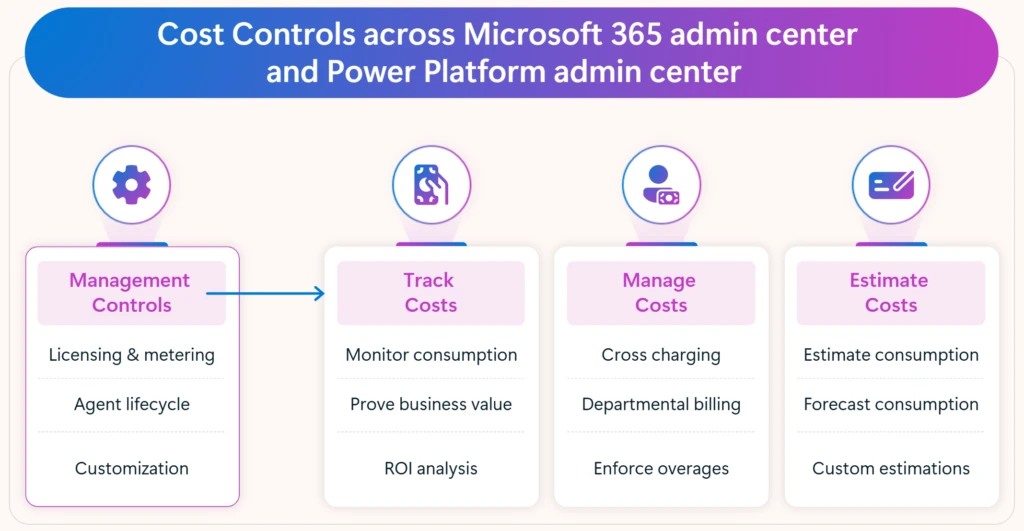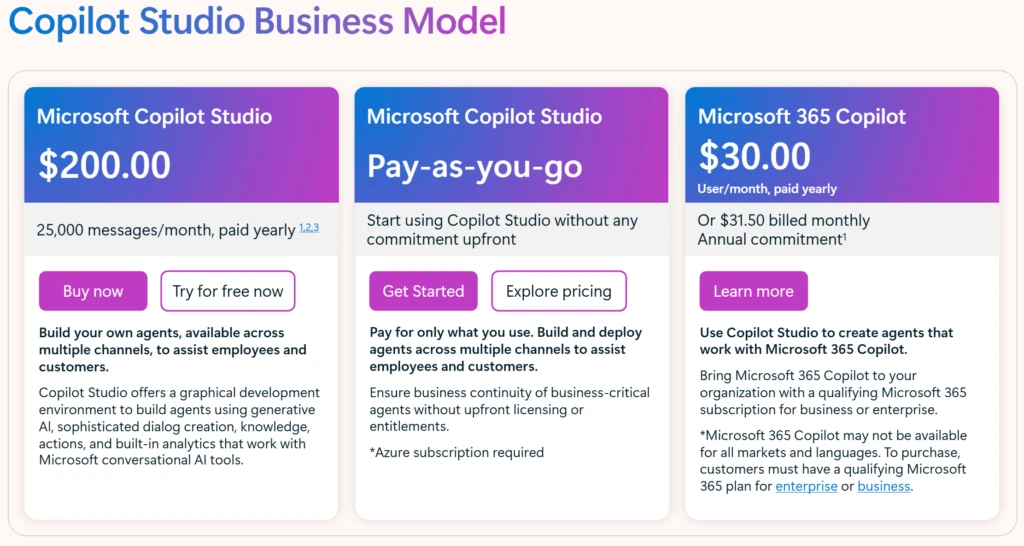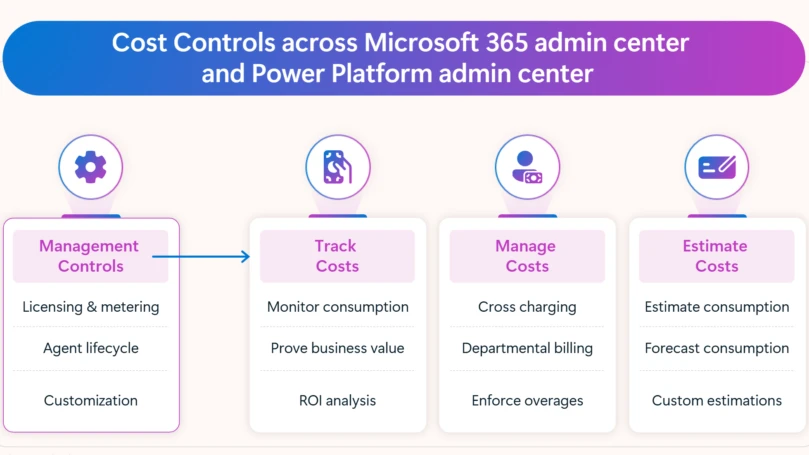As organizations accelerate their adoption of agents to automate tasks, enhance productivity, and deliver new customer experiences, they often face a critical new challenge: unpredictable costs. While consumption-based billing models like pay-as-you-go (PAYG) and prepaid message packs offer flexibility and agility, they can also introduce unexpected charges, budget overruns, and governance headaches if not proactively managed.
In a world where agentic solutions are moving from pilot projects to enterprise-wide deployments, understanding and controlling costs isn’t just a financial concern, it’s a key part of operational strategy. Without a clear approach, IT leaders risk losing visibility into agent spending, undermining ROI, and facing uncomfortable questions from finance teams and executives.
Learn more about Copilot Studio licensing: https://learn.microsoft.com/microsoft-copilot-studio/billing-licensing
Introducing Microsoft’s Agent Cost Management Approach
To help organizations confidently scale AI adoption while staying in control of costs, Microsoft has introduced a comprehensive agent cost management framework. This solution empowers IT leaders, administrators, and business decision-makers to estimate, track, forecast, and actively control agent-related expenses across Microsoft Copilot Studio and supporting platforms.

Whether you’re starting small with a few pilot agents or managing hundreds of agents across business units, this approach equips you with the tools and practices to align usage with budget, avoid surprises, and ensure every dollar spent on AI delivers value.
To learn more, read the new launched Agent Cost Management eBook: https://aka.ms/AgentCostManagement_Ebook
Watch the Cost Controls session
To see this in action, watch this session on agent cost controls presented by Kendra Springer, Isha Sahni, and Amiya Patra. We will do an introduction to agent cost controls, then walk you through the cost control product experience in Microsoft 365 admin center, Power Platform admin center, and end with a demo of the Agent Usage Estimator.
How It Works: Lifecycle Cost Management, from Estimation to Optimization
Microsoft’s agent cost management approach is designed as an end-to-end lifecycle.
Step 1: Estimation
To support this, Microsoft provides the Copilot Studio Agent Consumption Estimator (https://aka.ms/CopilotStudioEstimator). This tool allows organizations to forecast monthly message consumption, compare costs between Prepaid and PAYG billing models, and understand what messages might be covered under existing Microsoft 365 Copilot licenses.
Step 2: Billing Setup
Agents use “messages” as a common unit of usage across its capabilities. To meet varying needs, Microsoft offers three licensing options to give you flexibility based on your usage.
- Pre-paid – for more predictable usage, there’s the Message Pack option. It’s US$200 per tenant per month for 25,000 messages. You can buy it directly in the Microsoft 365 admin center. The message pack is applied at the tenant level, and you can buy multiple packs as needed. Learn more about Prepaid capacity at Buy and manage prepaid capacity.
- Pay-as-you-go (PAYG) – great for unpredictable or low-volume usage. You pay US$0.01 per message, and it’s billed through Azure. No upfront purchase is needed. To understand how the PAYG service works visit View costs and billing for Microsoft 365 Copilot pay-as-you-go and Setting up pay-as-you-go.
- Microsoft 365 User License – Copilot Studio is also included in the Microsoft 365 Copilot license, which is US $30 per user per month. This gives each licensed user full access to build agents. It’s available via your Microsoft licensing provider or in the Microsoft 365 admin center. Agents built in Copilot Studio for Microsoft Teams, SharePoint, and Microsoft 365 Copilot are included at no extra charge. Learn more about Microsoft Copilot Studio’s Billing rates and management

Step 3: Tracking and Forecasting
After deployment, you can view detailed reports that are available in the Copilot Control System (CCS) and Power Platform Admin Center (PPAC). Features include:
- Message consumption reports with user-level and agent-level breakdowns.
- Real-time alerts for high consumption, allowing proactive adjustments.
- Historical data views to support budget planning and trend analysis.
- Azure Cost Management integration for advanced analysis and automated governance workflows.
Learn more about Microsoft 365 reports in the admin center – Message consumption – Microsoft 365 admin | Microsoft Learn
Step 4: Active Management and Controls
Admins can:
- Manage who can create and use agents to prevent sprawl and reduce risk.
- Implement per-user and per-agent message limits to enforce fairness and prevent runaway costs.
- Use granular departmental billing to allocate costs to business units.
- Block or deactivate agents as needed to maintain policy compliance.
Additionally, organizations can switch between billing models as needs evolve. For example, they might move from PAYG to prepaid when usage grows, or adopt user licenses for teams with steady, predictable consumption. Future enhancements like per-agent consumption limits and budgeting controls within MAC will further strengthen financial governance.
Learn how to Prepare your organization for Microsoft 365 Copilot.
Conclusion
Agents hold tremendous potential to transform business operations, but without disciplined cost management, that potential can be undermined by financial risks and governance gaps. By adopting a lifecycle approach to agent cost management, organizations can confidently accelerate their AI journeys, knowing they have the tools to forecast, control, and optimize spending.
This proactive approach not only safeguards budgets but also strengthens trust with stakeholders, enabling broader and faster adoption of AI-driven solutions across the enterprise. It helps to ensure that every dollar invested in AI delivers measurable value, supports innovation, and drives competitive advantage. As organizations continue to expand their use of AI, having a clear strategy for cost management becomes a critical enabler of long-term success. By combining careful estimation, flexible billing models, continuous monitoring, and robust governance controls, businesses can create a scalable, sustainable foundation for AI growth.
Next Steps: Take control of your agent costs
Now is the time to take charge of your AI costs and turn potential risks into strategic opportunities for transformation.
- Read the full Agent Cost Management eBook: https://aka.ms/AgentCostManagement_Ebook
- Try the Copilot Studio Agent Consumption Estimator: https://aka.ms/CopilotStudioEstimator
- Watch the Cost Controls session: Agent Cost Controls
- Listen to Cost Controls Podcast: https://thelowcodeapproach.podbean.com/e/episode-93-copilot-cost-controls-w-amiya-and-isha/
- Explore detailed cost management documentation: https://learn.microsoft.com/power-platform/admin/manage-copilot-studio-messages-capacity
- Learn more about the Microsoft 365 Copilot pay-as-you-go plan: https://learn.microsoft.com/copilot/microsoft-365/pay-as-you-go/overview
- Manage Copilot agents in the Microsoft 365 Admin Center:
https://learn.microsoft.com/microsoft-365/admin/manage/manage-copilot-agents-integrated-apps?view=o365-worldwide



